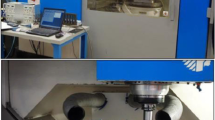Abstract
The problem of heat generation and distribution in edge trimming of carbon fiber-reinforced polymers (CFRP) was investigated. The heat diffusion problem in the cutting zone was modeled numerically and an inverse head conduction technique was applied to determine the heat partition. Measurements of boundary temperatures allowed the determination of the proper magnitude of heat flux applied to the workpiece and the cutting tool. It was found that less than 16% of the total heat is conducted into the workpiece and that higher feed speeds allowed less heat to conduct into the workpiece. The depth of heat penetration into the workpiece caused the temperature to reach the glass transition temperature of the epoxy only for the slower feed speed. When tested at the same feed per revolution, a PCD 2-flute end mill was the most effective tool in removing the heat from the cutting zone as compared to burr tools.
Similar content being viewed by others
References
Nor Khairusshima MK, Che Hassan CH, Jaharah AG, Amin AKM, MdIdriss AN (2013) Effect of chilled air on tool wear and workpiece quality during milling of carbon fibre-reinforced plastic. Wear 302:1113–1123
Zitoune R, Cadorin N, Collombet F, Šíma M (2017) Temperature and wear analysis in function of the cutting tool coating when drilling of composite structure: in situ measurement by optical fiber. Wear 376-377:1849–1858
Chatterjee A (2009) Thermal degradation analysis of thermoset resins. J Appl Polym Sci 114:1417–1425
Wang H, Sun J, Li J, Lu L, Li N (2016) Evaluation of cutting force and cutting temperature in milling carbon fiber-reinforced polymer composites. Int J Adv Manuf Technol 82(9–12):1517–1525
Kerrigan K, O’Donnell GE (2016) On the relationship between cutting temperature and workpiece polymer degradation during CFRP edge trimming. Procedia CIRP 55:170–175
Delahaigue J, Chatelain J-F, Lebrun G (2017) Influence of cutting temperature on the tensile strength of a carbon fiber-reinforced polymer. Fibers 5(46):5–16. https://doi.org/10.3390/fib5040046
Sölter J, Gulpak M (2012) Heat partitioning in dry milling of steel. CIRP Ann Manuf Technol 61(1):87–90
Brito RF, Carvalho SR, Lima E, Silva SMM (2015) Experimental investigation of thermal aspects in a cutting tool using comsol and inverse problem. Appl Therm Eng 86:60–68
García E, Méresse D, Pombo I, Harmand S, Sánchez JA (2014) Identification of heat partition in grinding related to process parameters, using the inverse heat flux conduction model. Appl Therm Eng 66(1–2):122–130
Shen B, Shih A, Xiao G (2011) A heat transfer model based on finite difference method for grinding. J Manuf Sci Eng 133:031001:1–10
Jiang F, Liu Z, Wan Y, Shi Z (2013) Analytical modeling and experimental investigation of tool and workpiece temperatures for interrupted cutting 1045 steel by inverse heat conduction method. J Mater Process Technol 213:887–894
Barrios A et al (2012) Modeling heat transfer in die milling. Appl Therm Eng 64:108–116
Liu J, Chen G, Ji C, Qin X, Li H, Ren C (2014) An investigation of workpiece temperature variation of helical milling for carbon fiber reinforced plastics (CFRP). Int J Mach Tools Manuf 86:89–103
Mkaddem A, Zain-ul-abdein M, Mezlini S, Bin Mahfouz AS, Jarraya A (2017) Sensitivity of GFRP composite integrity to machining-induced heat : a numerical approach. In: Fakhfakh T, Chaari F, Walha L, Abdennadher M, Abbes M, Haddar M (eds) Advances in acoustics and vibration. Applied condition monitoring, vol 5. Springer, Cham
Hintze W, Klingelhöller C (2017) Analysis and modeling of heat flux into the tool in abrasive circular cutting of unidirectional CFRP. Procedia CIRP 66:210–214
Ghafarizadeh S, Lebrun G, Chatelain J-F (2015) Experimental investigation of the cutting temperature and surface quality during milling of unidirectional carbon fiber reinforced plastic. J Compos Mater. https://doi.org/10.1177/0021998315587131
Furuki T, Hirogaki T, Aoyama E, Kodama H, Ogawa K (2014) Influence of tool shape and coating type on machined surface quality in face milling of CFRP. Adv Mater Res 1017:310–315
Yashiro T, Ogawa T, Sasahara H (2013) Temperature measurement of cutting tool and machined surface layer in milling of CFRP. Int J Mach Tools Manuf 70:63–69
Merino-Perez JL, Royer R, Ayvar-Soberanis S, Merson E, Hodzic A (2015) On the temperatures developed in CFRP drilling using uncoated wc-co tools part I: workpiece constituents, cutting speed and heat dissipation. Compos Struct 123:161–168
Kerrigan K, Thil J, Hewison R, O’Donnell GE (2012) An integrated telemetric thermocouple sensor for process monitoring of CFRP milling operations. Procedia CIRP 1(1):449–454
Duboust N, Ghadbeigi H, Pinna C, Ayvar-Soberanis S, Collis A, Scaife R, Kerrigan K (2017) An optical method for measuring surface roughness of machined carbon fibre-reinforced plastic composites. J Compos Mater 51(3):289–302. https://doi.org/10.1177/0021998316644849
Kim H-J, Kim N-K, Kwak J-S (2006) Heat flux distribution model by sequential algorithm of inverse heat transfer for determining workpiece temperature in creep feed grinding. Int J Mach Tools Manuf 46:2086–2093
Joven R, Das R, Ahmed A, Roozbehjavan P, Minaie B (2012) Thermal properties of carbon fiber-epoxy composites with different fabric weaves, Sampe 2012 - Charleston, SC
Luchesi VM, Coelho RT (2012) An inverse method to estimate the moving heat source in machining process. Appl Therm Eng 45-46:64–78
Author information
Authors and Affiliations
Corresponding author
Rights and permissions
About this article
Cite this article
Sheikh-Ahmad, J.Y., Almaskari, F. & Hafeez, F. Thermal aspects in machining CFRPs: effect of cutter type and cutting parameters. Int J Adv Manuf Technol 100, 2569–2582 (2019). https://doi.org/10.1007/s00170-018-2881-1
Received:
Accepted:
Published:
Issue Date:
DOI: https://doi.org/10.1007/s00170-018-2881-1




